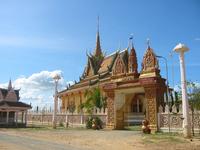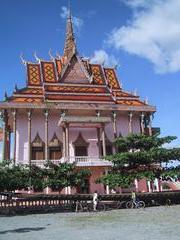Bangkok to Saigon Cycle Challenge 2003
People and country
Children—oodles of them!
One of the strongest and long lasting impressions we have brought
back from the trip are the many faces of children, particularly in
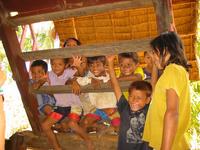
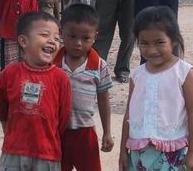
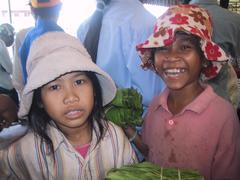 Cambodia, which seems to have incredible numbers of them. The country is
obviously going through a baby boom. In fact, population has more than
doubled since the overthrow of Pol Pot, and it seems reasonable to
suspect (and consistent with our impression of the age profile) that
much of that growth has happened in the last ten years or so, since the
end of the bloody civil war.
Cambodia, which seems to have incredible numbers of them. The country is
obviously going through a baby boom. In fact, population has more than
doubled since the overthrow of Pol Pot, and it seems reasonable to
suspect (and consistent with our impression of the age profile) that
much of that growth has happened in the last ten years or so, since the
end of the bloody civil war.
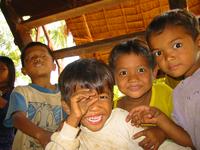 Overwhelmingly the children look well-nourished and healthy (and incredibly
cute!), but there are exceptions.
Which is not surprising, given the poor hygiene standards in Cambodia, with garbage
lying around everywhere and water generally being quite polluted. Also, availability
of medically trained people and medication is apparently poor in country areas.
Overwhelmingly the children look well-nourished and healthy (and incredibly
cute!), but there are exceptions.
Which is not surprising, given the poor hygiene standards in Cambodia, with garbage
lying around everywhere and water generally being quite polluted. Also, availability
of medically trained people and medication is apparently poor in country areas.
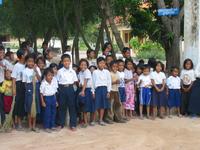
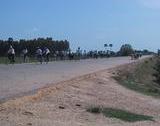 While in "civilised", built-up areas like Sydney most of
the children are hidden away from the public, here they are around us from early
in the morning until late. As we hop on our bicycles and ride along the roads,
we encounter kilometre-long processions of hundreds and hundreds of children, all
in the same uniforms on their way to and from
school, mostly biking, sometimes walking. But they are also lining the
streets when at home, as they are playing in front of their houses right next
to the street (and not tucked away inside in front of a TV or computer as often
there is no lighting inside; nor are they being driven around in cars
or buses out of sight and reach).
While in "civilised", built-up areas like Sydney most of
the children are hidden away from the public, here they are around us from early
in the morning until late. As we hop on our bicycles and ride along the roads,
we encounter kilometre-long processions of hundreds and hundreds of children, all
in the same uniforms on their way to and from
school, mostly biking, sometimes walking. But they are also lining the
streets when at home, as they are playing in front of their houses right next
to the street (and not tucked away inside in front of a TV or computer as often
there is no lighting inside; nor are they being driven around in cars
or buses out of sight and reach).
There is an interesting difference in school uniforms between
Cambodia and Vietnam. In Cambodia it's always a white shirt and blue
pants (boys) or skirts (girls). The younger ones wear shorts or short
skirts, while the older ones wear longs or ankle-long skirts. In Vietnam
the school uniform for the girls is (white) traditional ao dai,
which consists of loose ankle-long pants and a blouse with long panels
that also drop down to the ankles, looking like a skirt. They manage to
cycle in this without getting it dirty!


 In Cambodia, when children (and often also adults) see us on the road
from a distance, they would wave with their arms, shout "hello" or "bye,
bye" (!) and run towards the street, the more daring ones holding out
their hands for a clasp. In Thailand and Vietnam there is some
hello-ing too, but in Cambodia no child seems to want to miss the
chance to greet us.
In Cambodia, when children (and often also adults) see us on the road
from a distance, they would wave with their arms, shout "hello" or "bye,
bye" (!) and run towards the street, the more daring ones holding out
their hands for a clasp. In Thailand and Vietnam there is some
hello-ing too, but in Cambodia no child seems to want to miss the
chance to greet us.
 Every few kilometres there is a village stretched along the road with shady
trees. For our hourly rest stops, we typically pick such a shady place.
Within seconds of stopping children would accumulate around us, just
gazing and observing what we are doing. It's a bit of a feeling of being
in the zoo, but now on the inside of the cage ;-). Gernot is reminded of
when as a child he experienced a Porsche being parked on the schoolyard,
the event of the week...
Every few kilometres there is a village stretched along the road with shady
trees. For our hourly rest stops, we typically pick such a shady place.
Within seconds of stopping children would accumulate around us, just
gazing and observing what we are doing. It's a bit of a feeling of being
in the zoo, but now on the inside of the cage ;-). Gernot is reminded of
when as a child he experienced a Porsche being parked on the schoolyard,
the event of the week...
Maybe not all that surprising, really, given that for most of them we
would have been the first white people they had seen close-up in the
flesh, as opposed to on television or driving past in cars. Apart from
the capitals and Siem Riep, we ride through very rural areas with little
reason for a motorised tourist to stop.
Sometimes someone tries to exchange a few words in English.
Occasionally some older boy would ride along with us for a while and try
to make some conversation. However, it is always a challenge, and most
seem to speak no English at all. While everybody is incredibly
friendly, most children are extremely shy -- once when a local
adult tried to group them around us for a photo only few dared to.
Very rarely someone tries to touch Trudy's bare skin, which reminds her
of her own experience when, as a nine-year-old living in a village in
Switzerland, she first touched the skin of a black person from
Africa.
Houses and Life around it
 People in the Cambodian countryside live mostly in
traditional Khmer
houses—single-room and built on stilts. The stilts are, supposedly,
not to protect against flooding, but against wild animals. The houses are
entered via a retractable ladder (although these days it is often fixed
or replaced by stairs). It seems that the houses are mostly used for
sleeping (they are dark, as there is no electricity), much of daily life
happens under the house, protected from the sun and the
monsoon. Underneath the houses there are typically tables, benches and
hammocks.
People in the Cambodian countryside live mostly in
traditional Khmer
houses—single-room and built on stilts. The stilts are, supposedly,
not to protect against flooding, but against wild animals. The houses are
entered via a retractable ladder (although these days it is often fixed
or replaced by stairs). It seems that the houses are mostly used for
sleeping (they are dark, as there is no electricity), much of daily life
happens under the house, protected from the sun and the
monsoon. Underneath the houses there are typically tables, benches and
hammocks.
The interior of the houses (judging by the few occasions when we got
a glance inside) is kept very tidy and clean, in strong contrast to the
outside, where garbage seems to lie around everywhere.
 At Lake Tonlé Sap many people live in house boats, most of them are probably fishermen. The lake
is incredibly rich in fish, which is supposedly a result of the unusual way the
lake is fed with water. It normally drains via the Stung Tonlé Sap
River, which joins the Mekong at Phnom Penh. However, during the
wet season, the Mekong cannot drain all the water fast enough, and it
backs up, reverting the flow of the Stung Tonlé Sap into the
lake, which grows to more than twice of its minimal size. A big festival
marks the day when the river reverts to "normal" flow.
At Lake Tonlé Sap many people live in house boats, most of them are probably fishermen. The lake
is incredibly rich in fish, which is supposedly a result of the unusual way the
lake is fed with water. It normally drains via the Stung Tonlé Sap
River, which joins the Mekong at Phnom Penh. However, during the
wet season, the Mekong cannot drain all the water fast enough, and it
backs up, reverting the flow of the Stung Tonlé Sap into the
lake, which grows to more than twice of its minimal size. A big festival
marks the day when the river reverts to "normal" flow.
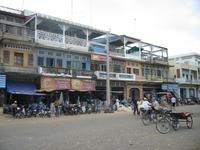 Large towns feature a mixture of wooden and stone houses. In some places
there are remnants of French colonial
townhouses, like the ones in the provincial capital Kampong Chhnang
shown on the left.
Large towns feature a mixture of wooden and stone houses. In some places
there are remnants of French colonial
townhouses, like the ones in the provincial capital Kampong Chhnang
shown on the left.
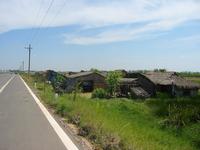
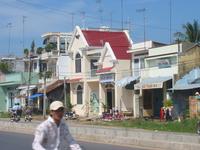 By contrast, in Vietnam we encounter almost only stone houses like the ones to the right. The
huts we pass just after the
border are an exception, we have seen only very few of those. They are
also markedly different in style from the Khmer houses.
By contrast, in Vietnam we encounter almost only stone houses like the ones to the right. The
huts we pass just after the
border are an exception, we have seen only very few of those. They are
also markedly different in style from the Khmer houses.
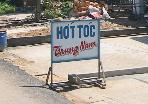 Interesting street sign. Wonder where Hot Toc lies ;-)
Interesting street sign. Wonder where Hot Toc lies ;-)
Pagodas—also lots of them

|

|

|
|
Thailand: First rest stop at the public grounds of a pagoda.
|
An other rest stop (still on the first day) at the public
grounds of a pagoda, now in the company of cows.
|
Cambodia: Pagodas on the hills of Sisophon.
|
Another rest stop at a pagoda just before
reaching Phnom Penh.
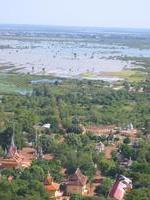
 An over-sized, brand new pagoda is being built to house one
of the most important relicts in Cambodia (a toe of the Buddha?). It is next
to a hill, on top of which is an older pagoda, majestically overlooking the surrounding flood plains
(but apparently not quite good enough to bear the honour).
An over-sized, brand new pagoda is being built to house one
of the most important relicts in Cambodia (a toe of the Buddha?). It is next
to a hill, on top of which is an older pagoda, majestically overlooking the surrounding flood plains
(but apparently not quite good enough to bear the honour).
It is amazing that there is money for such luxury when it is clearly
lacking everywhere else. Supposedly the funds all came from Cambodians
living abroad.
Street- / Village- / Town-Life

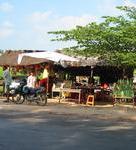
 There are many small shops along the road, many selling
basic groceries, like the two pictures on
the left (the first is in Thailand, the second in Cambodia). The stuff
in the green bottles isn't soft
drinks, it's two-stroke petrol for the many mopeds. At other places
there are proper mixing pumps, but
they apparently feel the heat too ;-)
There are many small shops along the road, many selling
basic groceries, like the two pictures on
the left (the first is in Thailand, the second in Cambodia). The stuff
in the green bottles isn't soft
drinks, it's two-stroke petrol for the many mopeds. At other places
there are proper mixing pumps, but
they apparently feel the heat too ;-)
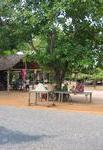
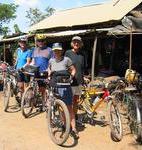 At some stands they simply sell pieces of sugar
cane, like in the left picture. And the right picture actually shows a
bicycle shop!
At some stands they simply sell pieces of sugar
cane, like in the left picture. And the right picture actually shows a
bicycle shop!

 Kampong Chhnang lies at the bottom of Lake Tonlé Sap, at least
when the lake lake is at its maximum size, as it was when we were
there. A fair bit of everyday life evolves around water: people
trading at the edge of the lake
as well as washing their
vehicles in a flooded piece of road.
Kampong Chhnang lies at the bottom of Lake Tonlé Sap, at least
when the lake lake is at its maximum size, as it was when we were
there. A fair bit of everyday life evolves around water: people
trading at the edge of the lake
as well as washing their
vehicles in a flooded piece of road.
Landscape
 Most areas we are riding through are extremely flat, with rice paddies along
both sides of the road. However, in Thailand some section are through undulating
country side, all very green being so soon after the monsoon season. Especially
in Thailand we also see some large tapioca and sugar cane plantations.
Most areas we are riding through are extremely flat, with rice paddies along
both sides of the road. However, in Thailand some section are through undulating
country side, all very green being so soon after the monsoon season. Especially
in Thailand we also see some large tapioca and sugar cane plantations.
Where Lake Tonlé Sap drains into the Stung Tonlé Sap River
there are many houses which, during this time of the year, are only
reachable by boat.
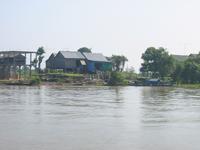
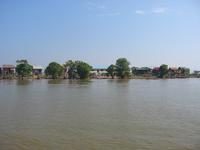
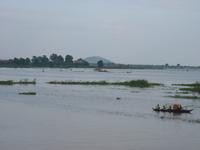
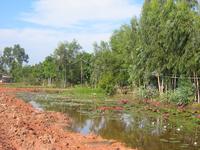
 West of Phnom Penh is dotted with many beautiful lakes largely covered with water
lilies. In fact, throughout Cambodia we encounter over and over again small bodies
of water full of beautiful plants and flowers—right next to the road!
West of Phnom Penh is dotted with many beautiful lakes largely covered with water
lilies. In fact, throughout Cambodia we encounter over and over again small bodies
of water full of beautiful plants and flowers—right next to the road!
Animals and Plants
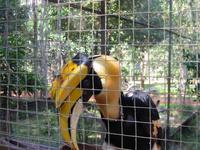
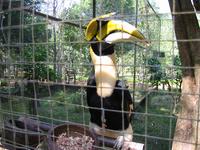 Impressive Yellow Hooded Hornbills are only
one of the many attractions in the (royal) bird breeding station we
visit near the border in Thailand.
Impressive Yellow Hooded Hornbills are only
one of the many attractions in the (royal) bird breeding station we
visit near the border in Thailand.
A rubber tree plantation in Vietnam.
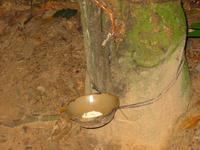
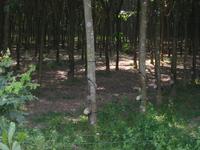
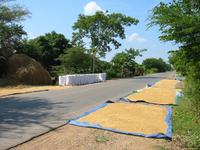 Rice is dried wherever there is space, including along or on the
middle of the road (seen both in Thailand and in Cambodia).
Rice is dried wherever there is space, including along or on the
middle of the road (seen both in Thailand and in Cambodia).
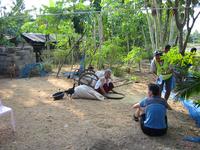
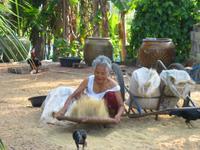 At a rest stop in Thailand, close to the Khmer border, an elder
lady sieves the rice chaff again for any leftover grains and feeds them to their
chicken. We didn't enquire why the chooks couldn't have done it themselves...
At a rest stop in Thailand, close to the Khmer border, an elder
lady sieves the rice chaff again for any leftover grains and feeds them to their
chicken. We didn't enquire why the chooks couldn't have done it themselves...
Practical Observations
Honesty
People will happily charge you "gringo price", at least a 100%
mark-up if you don't bargain. Is fair enough: if in Rome do as the
Romans do, and the Romans of South-East Asia bargain for every purchase.
However, we have never seen any sign of someone trying to
actually cheat us, nor did we ever have any disputes about return change
or US$/Riel exchange. We have not experienced any attempt to steal or
snatch anything off us (including Saigon,
where we were explicitly and repeatedly warned of pick-pockets). There
was never any attempt to only take the money without delivering the
product or service. To the contrary, the service was always delivered in
full before we have been asked to pay for it.
Modern communication
Phone land lines seem to be a real luxury in Cambodia, but, assisted
by the flat topography, the country has leap-frogged the need for this
by embracing cellular phone technology. Mobile phone coverage is
excellent in most places, and Ali and Reggie have used it extensively to
stay in contact with their families via SMS. Mobile phone usage is also
widespread among the population in towns, particularly with
businesses. Wherever we go we could see booths advertising mobile phone
contracts.
Internet access is available in all significant towns, although we
did not try it out—if you receive 100 emails a day, then checking it
is a perfect way to spoil a great holiday...
Return to main page of
Bangkok to Saigon Cycle Challenge 2003
© Gernot Heiser 2003.


 Cambodia, which seems to have incredible numbers of them. The country is
obviously going through a baby boom. In fact, population has more than
doubled since the overthrow of Pol Pot, and it seems reasonable to
suspect (and consistent with our impression of the age profile) that
much of that growth has happened in the last ten years or so, since the
end of the bloody civil war.
Cambodia, which seems to have incredible numbers of them. The country is
obviously going through a baby boom. In fact, population has more than
doubled since the overthrow of Pol Pot, and it seems reasonable to
suspect (and consistent with our impression of the age profile) that
much of that growth has happened in the last ten years or so, since the
end of the bloody civil war.















